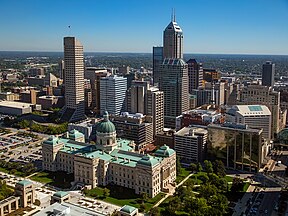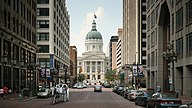
Back Indianapolis Afrikaans ኢንዲያናፖሊስ Amharic Indianapolis AN Indigabyrg ANG إنديانابوليس Arabic انديانابوليس ARZ Indianapolis AST İndianapolis (İndiana) Azerbaijani ایندیاناپولیس AZB Indianapolis BAN
Indianapolis | |
|---|---|
|
| |
| Nicknames: "Indy", "Circle City", "Crossroads of America", "Naptown", and others | |
 Interactive map of Indianapolis | |
| Coordinates: 39°46′07″N 86°09′29″W / 39.76861°N 86.15806°W | |
| Country | United States |
| State | Indiana |
| County | Marion |
| Townships | |
| Founded | January 6, 1821[1] |
| Incorporated (town) | September 3, 1831[1] |
| Incorporated (city) | March 30, 1847[1] |
| City-county consolidation | January 1, 1970[2] |
| Government | |
| • Type | Strong mayor–council |
| • Body | Indianapolis City-County Council |
| • Mayor | Joe Hogsett (D) |
| Area | |
| 367.93 sq mi (952.95 km2) | |
| • Land | 361.64 sq mi (936.64 km2) |
| • Water | 6.29 sq mi (16.30 km2) |
| Elevation | 718 ft (219 m) |
| Population (2020) | |
| 887,642 | |
| • Rank | 43rd in North America 16th in the United States 1st in Indiana |
| • Density | 2,454.50/sq mi (947.69/km2) |
| • Urban | 1,699,881 (US: 32nd) |
| • Urban density | 2,352.6/sq mi (908.4/km2) |
| • Metro | 2,111,040 (US: 34th) |
| Demonym | Indianapolitan[6] |
| GDP | |
| • State capital and consolidated city-county | $102.8 billion (2022) |
| • Indianapolis (MSA) | $184.4 billion (2022) |
| Time zone | UTC−5 (Eastern Time) |
| • Summer (DST) | UTC−4 (Eastern Daylight Time) |
| ZIP Codes | 56 total ZIP codes:
|
| Area codes | 317 and 463 |
| FIPS code | 18-36003[9] |
| GNIS feature ID | 2395423[4] |
| Website | indy |
Indianapolis (/ˌɪndiəˈnæpəlɪs/ ⓘ IN-dee-ə-NAP-ə-lis),[10][11] colloquially known as Indy, is the capital and most populous city of the U.S. state of Indiana and the seat of Marion County. Indianapolis is situated in the state's central till plain region along the west fork of the White River. The city's official slogan, "Crossroads of America", reflects its historic importance as a transportation hub and its relative proximity to other major North American markets.[12][13]
At the 2020 census, the balance population was 887,642.[14] Indianapolis is the 16th-most populous city in the U.S., the third-most populous city in the Midwest after Chicago and Columbus, Ohio, and the fourth-most populous state capital in the nation after Phoenix, Austin, and Columbus. The Indianapolis metropolitan area is the 34th-most populous metropolitan statistical area in the U.S., home to 2.1 million residents.[15] With a population of more than 2.6 million, the combined statistical area ranks 27th.[16] Indianapolis proper covers 368 square miles (950 km2), making it the 19th-most extensive city by land area in the country.
Indigenous peoples inhabited the area dating to as early as 10,000 BC.[17] In 1818, the Lenape relinquished their tribal lands in the Treaty of St. Mary's.[18] In 1821, Indianapolis was established as a planned city for the new seat of Indiana's state government. The city was platted by Alexander Ralston and Elias Pym Fordham on a 1-square-mile (2.6 km2) grid. Completion of the National and Michigan roads and later arrival of rail solidified the city's position as a major manufacturing and commercial center.[19] Since the 1970 city-county consolidation, known as Unigov, local government administration operates under the direction of an elected 25-member city-county council headed by the mayor.
Indianapolis anchors the 29th largest metropolitan economy in the U.S.[20] Prominent industries include trade, transportation, and utilities; education and health services; professional and business services; government; leisure and hospitality; and manufacturing.[21] The city has notable niche markets in amateur sports and auto racing.[22][23] Contemporary Indianapolis is home to two major league sports teams, three Fortune 500 companies, eight university campuses, and numerous cultural institutions, including the world's largest children's museum.[24][25] The city is perhaps best known for hosting the world's largest single-day sporting event, the Indianapolis 500.[26][27] Among the city's historic sites and districts, Indianapolis is home to the largest collection of monuments dedicated to veterans and war casualties in the U.S. outside of Washington, D.C.[28][29]
- ^ a b c Bodenhamer, David; Barrows, Robert, eds. (1994). The Encyclopedia of Indianapolis. Bloomington and Indianapolis: Indiana University Press. pp. 1479–1480. ISBN 0-253-31222-1.
- ^ Cite error: The named reference
Unigovwas invoked but never defined (see the help page). - ^ "2020 U.S. Gazetteer Files". U.S. Census Bureau. Retrieved March 16, 2022.
- ^ a b "Indianapolis". Geographic Names Information System. United States Geological Survey, United States Department of the Interior. Retrieved April 10, 2021.
- ^ "2020 Population and Housing State Data". U.S. Census Bureau. Retrieved August 22, 2021.
- ^ "Indianapolitan". Merriam-Webster.com Dictionary. Merriam-Webster. Retrieved August 1, 2016.
- ^ "Total Gross Domestic Product for Indianapolis-Carmel-Anderson, IN (MSA)". fred.stlouisfed.org.
- ^ "Gross Domestic Product by County and Metropolitan Area, 2022" (PDF). www.bea.gov. Bureau of Economic Analysis.
- ^ "U.S. Census Bureau". U.S. Census Bureau. Retrieved January 31, 2008.
- ^ Jones, Daniel (2003) [1917]. Peter Roach; James Hartmann; Jane Setter (eds.). English Pronouncing Dictionary. Cambridge: Cambridge University Press. ISBN 3-12-539683-2.
- ^
- "Indianapolis". Merriam-Webster.com Dictionary. Merriam-Webster.
- "Indianapolis". Dictionary.com Unabridged (Online). n.d.
- ^ "Metro Indianapolis Export Plan" (PDF). Indy Chamber. Archived from the original (PDF) on October 22, 2016. Retrieved August 16, 2016.
- ^ "Capital at the Crossroads of America–Indianapolis: A Discover Our Shared Heritage Travel Itinerary". National Park Service (U.S. Dept. of the Interior). Retrieved March 24, 2016.
- ^ Cite error: The named reference
QuickFacts22was invoked but never defined (see the help page). - ^ Cite error: The named reference
IBRC MSAwas invoked but never defined (see the help page). - ^ Cite error: The named reference
IBRC CSAwas invoked but never defined (see the help page). - ^ James R. Jones III, PhD.; Amy L. Johnson (2016). "Early Peoples of Indiana" (PDF). Indiana Department of Natural Resources Division of Historic Preservation and Archaeology. Archived from the original (PDF) on July 25, 2020. Retrieved August 11, 2020.
- ^ Cite error: The named reference
Encywas invoked but never defined (see the help page). - ^ Bodenhamer, David; Barrows, Robert, eds. (1994). The Encyclopedia of Indianapolis. Bloomington & Indianapolis: Indiana University Press. p. 190.
- ^ "Total Gross Domestic Product for Indianapolis-Carmel-Anderson, IN (MSA) [NGMP26900]". U.S. Bureau of Economic Analysis. FRED, Federal Reserve Bank of St. Louis. Retrieved May 20, 2023.
- ^ "Indianapolis Area Economic Summary" (PDF). U.S. Department of Labor Bureau of Labor Statistics. April 3, 2024. Retrieved April 15, 2024.
- ^ Rick Mattoon; Norman Wang (2014). "Industry clusters and economic development in the Seventh District's largest cities" (PDF). Economic Perspectives. pp. 56–58. Archived from the original (PDF) on October 22, 2016. Retrieved August 16, 2016.
- ^ Ted Greene and Jon Sweeney (January 20, 2012). Naptown to Super City (television broadcast). WFYI. Archived from the original on December 18, 2017. Retrieved March 26, 2016.
- ^ Clark, Andrew (May 21, 2018). "Fortune 500 list: Indiana RV manufacturer makes it for the first time". The Indianapolis Star. Retrieved August 2, 2019.
- ^ Quinn, Samm (January 2, 2020). "Children's museum reports record attendance in 2019". Indianapolis Business Journal. Retrieved August 12, 2020.
- ^ Keefer, Zak (April 30, 2016). "How the Indianapolis 500 became more than a race". The Indianapolis Star. Gannett Co. Retrieved May 29, 2022.
- ^ Davidson, Donald (2021) [1994]. "Indianapolis 500-Mile Race". Digital Encyclopedia of Indianapolis. Indianapolis Public Library. Retrieved May 29, 2022.
- ^ Mitchell, Dawn (May 25, 2015). "Monumental Indianapolis: Touring Indianapolis memorials". The Indianapolis Star. Retrieved March 25, 2016.
- ^ "Message from the Executive Director". Indiana War Memorial. Retrieved March 25, 2016.










